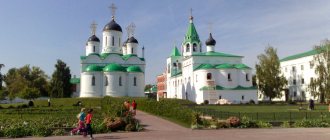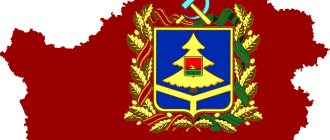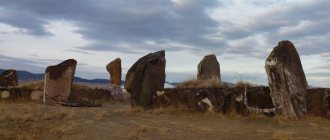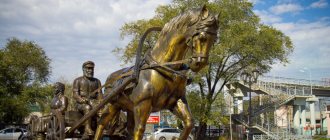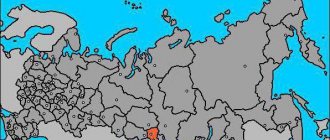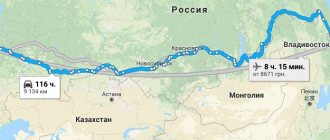Great Legacy
Murom was first mentioned in the 9th century. Nestor the Chronicler, the author of The Tale of Bygone Years, mentions the Murom tribe, the translation of which means “fun”. This means that there is a place in Russia that can be called a “city of fun.”
The history of the city is replete with many events, including tragic ones. In 1293, Murom was completely burned by the Mongol invaders and ceased to be mentioned in chronicles. This was the case until 1351.
The ancient city is part of modern Murom. Tourists come here from different parts of the country to visit ancient monasteries, see unusual architecture, and catch the aroma of “that time.”
Samples of ancient Russian art and art exhibits can be viewed in the city local history museum. The museum's collection includes sixty thousand exhibits.
Muromsky Bridge over the Oka River
The cable-stayed bridge across the Oka was built in 2009 in the southern part of Murom. Its characteristics are impressive: length - 1.4 km, width - 15 m, height of supports along the banks and in the middle - 85 m, carrying capacity - 5 thousand vehicles per day. According to the results of the All-Russian competition in 2013, the bridge was named the best in Russia. The Vladimir-Arzamas bypass highway passes over the bridge, bypassing Murom.
Muromsky Bridge over the Oka River
Geography of the city
The level of education of modern people is growing, and today every schoolchild knows where Murom is. This is good, because people should know their history. Murom is located on the Oka River. The distance from Moscow to Murom is 313.6 kilometers.
Geographically, Murom is located very advantageously and today it is considered an important railway junction. Summer here is warm. Winters, however, are cold, but a real Russian winter should be snowy and icy. Spring is short, but autumn comes protracted with heavy rains.
Legends and landmarks
If you enter Murom-grad from the regional center of Vladimir, then an epic stone will stand on the way. This is not without reason, because Murom is considered the birthplace of the hero from Russian epics - Ilya Muromets. Exhibitions, expositions, creative evenings, and meetings related to the figure of Ilya Muromets are constantly held here. There are scientists who dispute Murom’s right to the title of the birthplace of the famous hero.
There is an opinion that the hero of the epic was from the Bryansk region, another opinion is that from the Chernigov region. However, the residents of Murom unanimously answer the question - what region is the birthplace of Ilya Muromets? Of course, Vladimir region, the village of Karacharovo, near Murom.
Ilya Muromets is known not only for his heroic strength, but also for his deep faith. The hero is included in the Orthodox calendar, and parts of his bodily remains are kept in several churches in Murom.
There is a functioning monastery in the city. The full name is Spaso-Preobrazhensky Monastery. One of the brightest pages in the history of the monastery is the erection of the Transfiguration Cathedral by Tsar Ivan the Terrible in 1555. Leading the campaign against Kazan, the tsar stopped in Murom. Where he made a vow in case of his victory to erect a temple of stone. When Kazan was taken, Ivan the Terrible fulfilled his promise.
People coming to the monastery can take a walk by the local picturesque pond, visit the mini-zoo and taste bread from the monastery bakery.
Ilya Muromets
The most famous native of the Murom land is the epic hero Ilya Muromets, repeatedly mentioned in folklore not only of Russians, but also of neighboring peoples. The apparent contradiction of the previous sentence is deceptive. Many researchers consider Ilya Muromets to be a real historical character. And the collective story of his life is simply amazing. Everyone has heard about the hero’s exploits for the glory of the Russian land. But some details of his biography are not so well known.
The grandfather of Ilya Muromets was a convinced pagan. Once, in a fit of anger, he chopped up a Christian icon with an ax. The punishment fell on his grandson: Ilya could not walk since childhood, and all attempts to heal him were unsuccessful. The boy could only train his arms: his legs rested lifelessly on the stove. This continued until the age of 33 (the age of Christ!). Two “kalik passersby” (wandering beggars) entered his house and asked him to give them “intoxicating beer.” Ilya took their request as a mockery and said so. But the strange Kaliki were not embarrassed and repeated the request, which sounded more like an order.
Ilya, unexpectedly for himself... stood up and fulfilled the request. But the Kaliki did not drink, but ordered Ilya to do so, who after this felt great strength within himself. This can't happen? I agree, with only one addition: if we consider only the visible physical world to really exist. After all, the “Kalikas” who visited Ilya were...Christ with one of his apostles (as it was written in the pre-revolutionary editions of the epic about Ilya Muromets).
At the end of his life, Ilya Muromets decided to devote himself to God. He became a monk of the Kiev-Pechersk Monastery under the name of Elijah of the Pechersk. His relics rest in the Near Caves of the Lavra. Their study, conducted in 1988 by a commission of the Ministry of Health of Ukraine, gave results confirming the epic descriptions.
The relics belonged to a very physically strong man, approximately 50 years old, 1m 77 cm tall (in the 12th century, the average male height did not exceed 165 cm). He did suffer from polio in his youth, and his bones showed signs of many battles and blows with swords and spears, broken ribs and broken collarbones. Researchers named the cause of death as a blow to the chest from a sword or spear. It is assumed that this happened during the capture of Kyiv by Prince Rurik, when the Pechora Lavra was destroyed by the Polovtsians who were part of the prince’s army. In 1643, the Monk Ilya Muromets became a saint of the Russian Orthodox Church.
The connection between history and modernity
There are not many cities on the map of Russia with a thousand-year history. And Murom is one of them. Every year on July 8, the Day of Family, Love and Fidelity is celebrated here. This holiday has its roots in antiquity and is directly connected with Murom. The love story of Saints Peter and Fevronia is worthy of respect; it is not for nothing that the memory of it has been preserved through the centuries.
Having overcome all the obstacles that were placed in their unequal union, they overcame all adversity together and rightly ruled in Murom at the beginning of the thirteenth century. Legend has it that a married couple took monastic vows in their declining years and, having lived a righteous old age, Peter and Fevronya died on the same day.
In Murom, a monument was erected to Peter and Fevronia, where, according to a glorious tradition, wedding processions arrive. The newlyweds believe that the blessing of Peter and Fevronia will allow them to live a long and cloudless family life.
Leisure and relaxation
The map of the city of Murom contains a lot of places where you can have a great time and take great photos. The main ones are:
1. Old town, namely the buildings of the 19th century. The architecture of that period is distinguished by the fact that the lower floors were made of stone, and the top of the buildings was built of wood. People living in the 19th century were convinced that stone housing was harmful to health. The first floors served as work premises, and the 2nd and 3rd floors, built of wood, were residential.
Unfortunately, ancient streets remarkable for their curvature have not been preserved in Murom. By decree of Empress Catherine the Great, all narrow streets were rebuilt into wide avenues.
2. Shopping arcades of the nineteenth century attract tourists with the Empire style - the style of late (high) classicism.
3. It is worth paying attention to the water tower, which in the 19th century the then mayor built with his own savings. Surprisingly, at that time there was no running water in many Russian large cities, for example in Vladimir. Water was pumped from springs, and the tall water tower itself served as a fire tower. The water was redirected to the houses of the townspeople, as well as to sixteen fountains. The pipes through which the water flowed were made of hardwood. There are chimes on the tower, the music on which was turned off at the request of residents of nearby houses - due to the sound being too loud.
4. Oksky Park is another attraction that can be shown on the map of Murom. The place attracts with attractions for children, alleys for walking, and benches for relaxation. There is a gorgeous observation deck here that offers an incredible view of the city. It is here that there stands a huge statue of the epic hero Ilya Muromets, 21 meters in size. And lovers of extravagant photos will love the suspension bridge over the Oka River against the backdrop, which creates unusual shots. These attractions are the hallmark of the ancient Russian city in the modern world.
5. City guests who come with children are strongly recommended to take their kids to the bread room. It is open at a local bakery and here the children will definitely be offered to paint their own gingerbread with icing. The children make their own frosting for baking. And on the eve of holidays, such as Maslenitsa or Christmas, the most interesting master classes on preparing delicious baked goods are held in the upper room.
6. Lovers of antiquity should check out the Murom Historical and Art Museum. Exhibits are stored here indicating that primitive people lived on the territory of Murom.
7. Murom has an Ice Palace where you can go ice skating, as well as cinemas, restaurants, nightclubs, bowling alleys, children's entertainment centers and many other interesting places.
Oka Garden
Once upon a time, on the territory of the current garden there was a dilapidated wooden Murom Kremlin, which in the 18th century. had to be taken apart. In the middle of the next century, on the initiative of the mayor, Prince Trubetskoy, it was decided to lay out a city garden in this place. Among the current vegetation of the garden, only elms have survived from that time. The garden located on a hill offers beautiful panoramas of the Oka and the city. The main buildings of the garden are the monument to Ilya Muromets and the fountain.
Monument to Ilya Muromets in Oka Garden
In the 21-meter monument, the sculptor Klykov embodied the two forms of Ilya Muromets - the defender of the Russian Land and the monk. In his right hand is a formidable sword, and in his left is a cross. A monastic robe is visible from under the chain mail. On the platform of the pedestal there are images of griffins - symbols of victory and power.
In memory of Murom
Those who saw the coat of arms of the city of Murom, of course, paid attention to the three golden rolls. What do these baked goods mean on the coat of arms of the ancient city? Old-timers say that Murom has been famous throughout the country for its baked goods since the time of Catherine the Second.
Rolls of all sizes are sold in bakeries and branded stores. The most popular kalach among the people is baked in the shape of a castle. Such a roll will be an excellent gift from the city of Murom.
In Murom souvenir shops, the following are in particular demand:
- Figures of fairy-tale and epic heroes. The first place in popularity is, of course, occupied by Ilya Muromets.
- Skillfully made copies of ancient jewelry.
- A free souvenir from Murom is clean spring water.
Village Karacharovo
The former village of Karacharovo is now a microdistrict of Murom. Its main attraction is house number 279 on the street. Priokskaya, where the hero was born and lived. Those living here today have no doubt that they are his direct descendants. Nearby is the Trinity Church, founded by the hero himself. The dilapidated building is now being restored, its bell tower with the chapel of Ilya Muromets has been restored.
Trinity Church
A nearby holy spring with a bath began to flow from the blow of the hooves of Ilya’s mighty horse.
Holy spring with bath
